Brian Clegg's Blog, page 50
September 1, 2016
What are the chances?
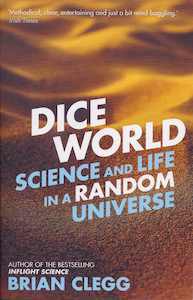 Randomness is something that most of us struggle to understand - it's one of the main reasons I wrote my book
Dice World
to explore the influence of randomness and probability on our lives. I try to make randomness something that's better understood by the reader.
Randomness is something that most of us struggle to understand - it's one of the main reasons I wrote my book
Dice World
to explore the influence of randomness and probability on our lives. I try to make randomness something that's better understood by the reader.However, not everyone has read the book (yet) and confusion caused by randomness often comes up in the media. So, for example, in a recent article on jury service entitled What Are You Chances of Being Called up Again and Again we were regaled with the statement
Plenty of people go through their lives never being summoned; others are called repeatedly. Is selection really, as the government says, entirely random, or is something else at work here?Now, to be fair to the writer of the article, Patrick Collinson, he does go on to explain that, yes, it is entirely random. But there is definitely a strong implication in that statement that the selection process can't be random if some people get repeated calls and others none.
This is an indirect example of the process known as clustering. We tend to assume that randomness means that the results are well spread out, but actually something that occurs at random tends to crop up in groups, with gaps. When a series of events happen one after the other (clustered in time) or at the same location (clustered in space) we tend to assume that there is a linking cause, that this can't be a totally random occurrence. Historically this effect might have resulted in, say, a cluster of illnesses being blamed on a witch - these days (in many countries, at least) it's more likely to be a phone mast, power lines or a nuclear plant that gets the blame. This doesn't mean, of course, that clusters can't have a cause - however, just because there is a cluster doesn't mean that it has a cause.
So, if selection is truly random, we should expect some people to be called for jury service many times and many never. (Me included, so far.) A useful analogy is to think of taking a tin of ball bearings and dropping them on the floor. You would be really surprised if the balls were all neatly, evenly spread out across the floor. It seems perfectly reasonable that in reality some will be clustered together and there will be gaps with nothing. That's because we don't expect causality here. But in any circumstance with a little more room for causality, such as jury selection, our brains lose their grip on randomness, look for conspiracy and get it very wrong.
Published on September 01, 2016 01:57
August 31, 2016
Grace Paley - The Collected Stories - review
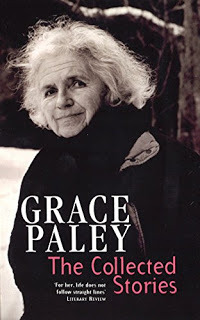 Traditional holiday reading involves the huge, wrist-bending saga, but my favourite books to take away on a break are collections of short stories. There's something about the ephemeral nature of short stories that fits perfectly with that strangely detached-from-reality feeling of being on holiday. This year I'm opting for three very different collections: Sandlands by Cambridge academic and novelist Rosy Thornton, Rogues - a mostly fantasy collection edited by George R. R. Martin and Gardner Dozois, and here
The Collected Stories of Grace Paley
.
Traditional holiday reading involves the huge, wrist-bending saga, but my favourite books to take away on a break are collections of short stories. There's something about the ephemeral nature of short stories that fits perfectly with that strangely detached-from-reality feeling of being on holiday. This year I'm opting for three very different collections: Sandlands by Cambridge academic and novelist Rosy Thornton, Rogues - a mostly fantasy collection edited by George R. R. Martin and Gardner Dozois, and here
The Collected Stories of Grace Paley
.A while ago on Facebook some of my friends with far more experience in good fiction than me were enthusing over the short story writing of Grace Paley, so I determined to give her writing a go. I'm glad I did - but, if I'm honest, the stories just don't work for me and I gave up about two thirds of the way through. I had two problems with these mostly short short stories set in a seedy period New York (contemporary when written) - the style and the content.
The style problems were a mix of language and Paley trying a bit too hard to be 'literary'. As far as language goes, the experience of reading this was a little like reading Shakespeare - it takes a while to tune into the style - the use of words here just isn't quite normal. All too often I'd have to read a phrase two or three times and would still think 'I haven't a clue what that means.' Because I was having to concentrate on every word, the reading experience was less enjoyable than usual and it also meant that I found myself going into editing mode: 'That's a comma splice - how could she do that! There shouldn't be a capital letter after that colon!' Perhaps worst of all, I hate the affectation that Paley regularly exhibits of writing speech without inverted commas. Sometimes the writing verged on the arch with statements such as 'Nighttime came and communication was revived at last by our doorbell, which is full of initiative.' No it's not.
As for content, I'll be honest I'm not particularly interested in what it was like to live in the poor parts of New York back in the day, but more critically it's the type of content that doesn't do it for me. I'd draw a parallel with a run-in I had with BBC Radio 4's series The Listening Project. Some while ago I was on Radio 4's Feedback programme moaning about The Listening Project, which I find deadly dull. I called it Big Brother for the chattering classes, as it replaces well-written material with the wonders of 'reality', but in a very middle class way. The content of Paley's stories provides soap opera for the same kind of audience. And that's just not something that engages me.
I don't deny that these are well-crafted stories, or that some will find them wonderful. I hope you will. They just don't work for me.
The Collected Stories is available from amazon.co.uk and amazon.com.
Published on August 31, 2016 00:19
August 30, 2016
Can language trump logic?
 In his book
Professor Stewart's Horde of Mathematical Treasures
, Ian Stewart describes a number of incidents of mathematicians struggling with ordinary life. In one we find Abraham Fraenkel, a mathematics professor 'of German origin' getting on a bus in Tel Aviv that was still in the bus station 5 minutes after it should have left. According to Stewart, Fraenkel waved a timetable at the driver, who replied 'What are you - a German or a professor?' to which, he tells us Fraenkel replied 'Do you mean the inclusive or, or the exclusive or?'
In his book
Professor Stewart's Horde of Mathematical Treasures
, Ian Stewart describes a number of incidents of mathematicians struggling with ordinary life. In one we find Abraham Fraenkel, a mathematics professor 'of German origin' getting on a bus in Tel Aviv that was still in the bus station 5 minutes after it should have left. According to Stewart, Fraenkel waved a timetable at the driver, who replied 'What are you - a German or a professor?' to which, he tells us Fraenkel replied 'Do you mean the inclusive or, or the exclusive or?'Interestingly, in English at least (this may not apply in other languages), the professor's snippy logic was beaten by linguistics, as his question was not necessary.
Fraenkel's question distinguished the exclusive or (where something has to be one thing or the other but can't be both) from the inclusive (where it can be either or both). And had he received the question from the bus driver in writing, with a slightly different wording, he would have been justified in asking the question. 'Are you a German or a professor?' written down could be inclusive or exclusive. However there was that opening word. It would have been clearer had the driver said 'Which are you' - this would force the exclusive. But even 'What are you' implies the exclusive.
However, the question wasn't written down - and interestingly, in spoken English we distinguish the inclusive and exclusive or by inflection. So had the driver said 'Are you a German or a professor?' and meant it to be inclusive he would have kept the word 'professor' at a fairly balanced or a rising pitch. If he had meant it to be exclusive, he would have said 'professor' with a falling pitch.
It's not really language trumping logic, as I asked in the title, but rather the interesting point that a phrase, particularly a spoken phrase, can contain more information than that of the basic interpretation applied by Abraham Fraenkel.
Published on August 30, 2016 01:08
August 29, 2016
Rogues - Review
 Traditional holiday reading involves the huge, wrist-bending saga, but my favourite books to take away on a break are collections of short stories. There's something about the ephemeral nature of short stories that fits perfectly with that strangely detached-from-reality feeling of being on holiday. This year I'm opting for three very different collections: Sandlands by Cambridge academic and novelist Rosy Thornton, The Collected Stories of Grace Paley, and here Rogues - a mostly fantasy collection edited by George R. R. Martin and Gardner Dozois.
Traditional holiday reading involves the huge, wrist-bending saga, but my favourite books to take away on a break are collections of short stories. There's something about the ephemeral nature of short stories that fits perfectly with that strangely detached-from-reality feeling of being on holiday. This year I'm opting for three very different collections: Sandlands by Cambridge academic and novelist Rosy Thornton, The Collected Stories of Grace Paley, and here Rogues - a mostly fantasy collection edited by George R. R. Martin and Gardner Dozois.Given the respective genres the editors write in, I assumed that Rogues , a fat collection of short stories edited by George R. R. Martin and Gardner Dozois, would be a mix of fantasy and SF stories, but in fact the 21 stories (mostly fairly long, in the 30-50 page range) are predominantly fantasy with a couple of crime stories and only one solidly science fiction piece.
All but a couple of the stories are good, but I was surprised to find that the ones that captivated me most were the 'straight' stories, particularly a highly entertaining tale by Bradley Denton involving the theft of a high school sousaphone and a dodgy teacher's attempts to muscle in on the action. As is the case with all the stories, the main character is something of a rogue - but also like most of them, a likeable one.
Although I'm not a great fan of swords and sorcery fantasy books, I found the short stories (which are mostly in this style), perhaps because of the tongue-in-cheek rogue main characters, highly entertaining, and in a couple of cases I noted down an author for further reading. I'm wondering if this sampler effect is why the book is such amazingly good value - a 900+ page paperback for just £2. Whatever the reason it's a great read.
Interestingly, of the three big names in the book, only one came across well - this was Gillian Flynn, whose books I've never read, but who provides a thoughtful non-fantasy tale. The story I was most looking forward to was by Neil Gaiman - and this was a significant disappointment. I love urban fantasies, and Gaiman's Neverwhere is one of my favourite books. This story is situated in the same world and features that amiable rogue the Marquis de Carabas, but it very much felt like a piece that was written because it had been commissioned - it just didn't work as a good short story.
The absolute low point for me was the George R. R. Martin 'story' that finishes the book. Even if you are a Game of Thrones fan (which I'm not), you might like to read this first to get it out of the way, as it is dire as a short story. It is to his books what the Silmarillion is to Lord of the Rings - essentially a set of background historical information but containing far too much 'history' and very little story. What it reminded me of most was that part in Alice's Adventures in Wonderland when everyone is wet from the pool of tears and the mouse recites an extract from a truly dull history book as 'the driest thing I know.' It's exactly that kind of writing.
Don't let that put you off though - losing the Martin contribution still leaves over 850 pages of excellent, entertaining stories. Avoid this collection if you can't stand fantasy, but if you tolerate it, this is a fantastic (in every way) book.
Rogues is available from amazon.co.uk and amazon.com.
Published on August 29, 2016 02:21
August 19, 2016
Wonderful things
 Although most of my work remains in the non-fiction arena, I'm an enthusiastic writer of both crime and science fiction, and as far as SF goes, I have a number of short stories published. The journal Nature, which carried my story Wonderful Things, put together an interesting podcast, intertwining input based on my story and reflections on an opinion piece from Nature proper, both of which concern the very long-term future handling of nuclear waste.
Although most of my work remains in the non-fiction arena, I'm an enthusiastic writer of both crime and science fiction, and as far as SF goes, I have a number of short stories published. The journal Nature, which carried my story Wonderful Things, put together an interesting podcast, intertwining input based on my story and reflections on an opinion piece from Nature proper, both of which concern the very long-term future handling of nuclear waste.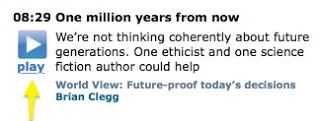 You can read the short story here, and you can listen to the podcast here - the segment is only a few minutes long, accessed from the 'One million years from now' play button on the left hand side of the page once you've clicked through (see illustration to right).
You can read the short story here, and you can listen to the podcast here - the segment is only a few minutes long, accessed from the 'One million years from now' play button on the left hand side of the page once you've clicked through (see illustration to right).
Published on August 19, 2016 00:56
August 18, 2016
Thinking Musically - review
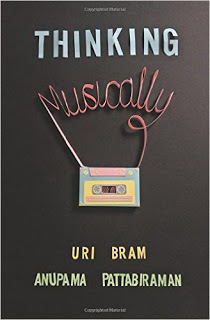 It's difficult to know exactly how to classify Thinking Musically. It isn't a science of music book, though it does have a small amount of scientific content. Nor can it really be considered a basic music theory book, given it never mentions musical notation. I can best describe it as a book that gives a feel for what's going on in music without getting technical, so the reader can get think through, for instance, why some music sounds happy and other pieces sad, simply as a result of choosing a particular 'palette' of notes.
It's difficult to know exactly how to classify Thinking Musically. It isn't a science of music book, though it does have a small amount of scientific content. Nor can it really be considered a basic music theory book, given it never mentions musical notation. I can best describe it as a book that gives a feel for what's going on in music without getting technical, so the reader can get think through, for instance, why some music sounds happy and other pieces sad, simply as a result of choosing a particular 'palette' of notes.We start with some basics on the nature of sound and pitch. These are illustrated using wiggly side to side (roughly sinusoidal) waves to represent sound waves. Uri Bram and Anupama Pattabiraman qualify this by saying 'This is the easiest way to imagine what a wave looks like, even if it's not 100% accurate.' That's fine, but it really wouldn't have been hard to explain that in reality sound is a compression wave, with alternating squashed up and thinner air, so the model waves they use could be considered a picture of higher and lower pressure areas.
The tone throughout the slim volume (I read it in a couple of hours) is light and conversational. This mostly works well, though when the authors resort to humour it can be rather wince-making, as when they suggest twanging a rubber band repeatedly close to someone's ear, then say 'What, you actually did it? We were kidding. Oh dear.' Oh dear.
I liked the way that Bram and Pattabiraman emphasised the importance of relative pitch, illustrating it with a coffee shop cups metaphor, and showing how, for example, semitones cannot be equally spaced but depend on that relative spacing. To be honest, though, I got a bit bored by the lengthy description of how the notes fit on a piano keyboard and how they are named. However, things got interesting again once we got onto scales, especially when exploring the way that different but consistent spacing sequences separate major and minor, though why the authors had to drag the obsolete tonic sol-fa system in, I'm not sure - it only served to obscure.
Something that came through strongly in this section was a need for wider context. Almost all references were to pop music, which led to the suggestion that almost all Western music uses the conventional scales - but this ignores pretty well all serious music pre-Bach (when, for example, in one period music was often effectively written in a different key in the same piece depending on whether the line is ascending or descending) and much serious music written post 1900 when traditional scales are often ignored. In fact, all the way through I felt I'd like a bit more. For instance in page 75 there's a reference to the tritone interval, considered the work of the devil (figuratively) in the Middle Ages, but just 7 pages earlier, the authors highlight the striking second note of the song Maria from West Side Story, without pointing out that the interval that makes it sound so dramatic... is a tritone.
All in all, this is a really interesting little book (perhaps a little overpriced for its length), presenting music basics in an interestingly different way, but it could do with a little filling out with context - both in musical history and, perhaps, some more stories about composers and musicians much as a good popular science book might tell us about scientists - to keep the interest going.
Thinking Musically is available from amazon.co.uk and amazon.com.
Published on August 18, 2016 01:13
August 17, 2016
Are those clip-on lenses worth it? - review
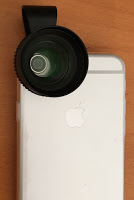 I don't know about you, but I've always wondered if those clip-on lenses for smartphone cameras were worth using. I've had a chance to try a couple out, and here's what I thought:
I don't know about you, but I've always wondered if those clip-on lenses for smartphone cameras were worth using. I've had a chance to try a couple out, and here's what I thought:A modern smartphone has a camera that is more than adequate for most of the everyday snaps we take - and having the camera with you all the time more than outweighs any disadvantage from having a single, non-zoom lens. But there are occasions when you really would like to have a telephoto lens to get closer to the action, or to take a landscape shot, homing in on a particular detail. Although you can zoom digitally, this drastically reduces the resolution, often producing fuzzy pictures.
 The clip-on telephoto lens I tried, the niftily named Havit HV-MPC04, provides a decent optical 2x telephoto to get in closer to your subject without noticeable loss of quality. It's a good looking lens and produces clear, effective shots (in the photos alongside, the side-by-side photo shows the straight camera image and the same image with the telephoto lens in place). The lens, which comes with a cap, attaches easily to a clip, fitting over the top of the phone as shown. By looking through the lens itself it's easy to see when it's aligned with the phone's camera, and then the camera is simply used as normal.
The clip-on telephoto lens I tried, the niftily named Havit HV-MPC04, provides a decent optical 2x telephoto to get in closer to your subject without noticeable loss of quality. It's a good looking lens and produces clear, effective shots (in the photos alongside, the side-by-side photo shows the straight camera image and the same image with the telephoto lens in place). The lens, which comes with a cap, attaches easily to a clip, fitting over the top of the phone as shown. By looking through the lens itself it's easy to see when it's aligned with the phone's camera, and then the camera is simply used as normal. The lens comes in a robust if surprisingly large hard case, making it easy to pop in the pocket and have ready for use. The make-or-break here is whether you are prepared to carry the separate lens with you all the time, and to take the time to remove it from the case and clip it on when you want to take the relevant shot.
The lens comes in a robust if surprisingly large hard case, making it easy to pop in the pocket and have ready for use. The make-or-break here is whether you are prepared to carry the separate lens with you all the time, and to take the time to remove it from the case and clip it on when you want to take the relevant shot.I suspect I won't carry it all the time, but I will have it with me on occasions I feel I might need to get that telephoto image - on walks, for instance, or on holiday - and I am sure that my photographs will be significantly better as a result. A 2x magnification may not seem vast, but for shots of scenery or wildlife it will seriously improve the final image.
The Havit HV-MPC04 is available from amazon.co.uk and amazon.com.

I also tried out a wide-angle lens from the same manufacturer (the Havit HV-MPC03), which is very similar in concept, but gives a wider view. The case and operation are identical and here's the side-by-side view with the basic camera shot on the left.
I think I'm likely to use this less than the telephoto, but it will sometimes come in for those shots - for instance of a building in a city - where you can't get far enough away from the subject.
The Havit HV-MPC03 is available from amazon.co.uk and amazon.com.
Published on August 17, 2016 00:59
August 16, 2016
Streaming, Sharing, Stealing review
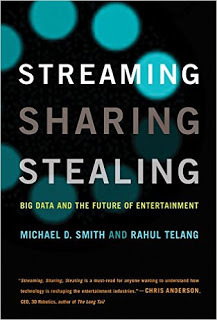 Because it's from a university press, I must admit I expected Streaming, Sharing, Stealing to be a somewhat dull economic textbook - but in reality it is a great read and a cracking business book, giving the clearest explanation I've ever seen of what is happening to three arms of the entertainment business - book publishing, music and TV/film - in the face of the internet/digital revolution.
Because it's from a university press, I must admit I expected Streaming, Sharing, Stealing to be a somewhat dull economic textbook - but in reality it is a great read and a cracking business book, giving the clearest explanation I've ever seen of what is happening to three arms of the entertainment business - book publishing, music and TV/film - in the face of the internet/digital revolution.In that sense the title is misleading, as it seems to suggest that a major focus is music sharing and piracy. This is certainly is covered, but is dismissed as the relatively easy part. Like most of the analysis in the book, here Michael D. Smith and Rahul Telang make sure that their views are backed up with as much experimental data as possible - and there appears to be good evidence that piracy isn't too big a deal, provided it's made easy to get access to legal digital versions in a timely fashion. It's where the publishers/networks either have poor online access or delay it til after, say, a DVD or hardback comes out that problems arise.
However, the main issue that Smith and Telang cover is the challenge that book and music publishers and the film studios/TV networks face in dealing with the internet giants. As the authors point out, the entertainment industries coped fine with new technology throughout the 20th century because they had control of the source material and distribution, and so were complacent when faced with the internet. But here, several major changes came together - Smith and Telang draw a parallel with the 'perfect storm' - and the old big names are potentially in trouble. The authors show how Amazon, iTunes and Netflix (as key examples) mean real trouble for those who used to pull the strings, particularly because of the newcomers' access to customer data, and ability to give customers what they are looking for, rather than just put out what they think customers might want and hope.
The analysis is often brutal and displays some outcomes from experiment that might surprise the publishers. For example, they found that when ebooks or digital versions of TV and film came out at the same time as DVDs and hardbacks, the overall take went up, but if they were held back to let more expensive DVDs and hardbacks have first shot - which was the traditional model used by most publishers and studios - digital sales plummeted, because digital users didn't buy the hardback/DVD instead, but either got a pirate version or just went for something else.
As well as individual lessons like this, the book does offer a little hope for the beleaguered publishers and studios as long as they can change their mindset - but it also seems likely that they will be like Kodak in the photography business, leaving it too late. As the authors make clear, it's not enough for individual publishers or studios to have their own online store, because few customers actually know or care who their favourite author/band is published by, or which network or studio produced what they want to watch. The only hope is if the content providers can band together and have a joint digital location with timely releases. But this doesn't augur well, as the the one attempt the networks have made, Hulu, has been shackled, forcing advertising and late releases on it.
If you are interested in the media and how the digital age is threatening the old world and transforming our entertainment environment, you need to read this book.
Streaming, Sharing, Stealing is available from amazon.co.uk and amazon.com.
Published on August 16, 2016 01:14
August 15, 2016
Ticket to Ride: Europe - review
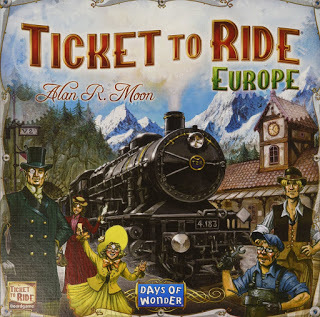 If, like me, you have no interest in the Olympics (or even if you do) you might feel for the need for a distraction - and if you do, I can heartily recommend the Ticket to Ride board game.
If, like me, you have no interest in the Olympics (or even if you do) you might feel for the need for a distraction - and if you do, I can heartily recommend the Ticket to Ride board game.For between two and five players, the game involves building rail routes across Europe. To build the routes you need cards with appropriately coloured wagons, picked up two at a time as a go in the game, and there are various additional considerations to cover, such as a set of specific routes you need to build if you are to have a chance of winning (allocated by randomly selected cards), and a bonus for the player with the longest single route at the end of the game.
The play is an excellent balance of luck (how you build your route is dependent on which cards you pick up) and strategy/tactics, meaning that a good player will usually win, but a less skilled player can win occasionally, so doesn't feel it's pointless to try. You don't have to be interested in trains, by the way - that part is almost incidental - it's effectively about building a network.
To begin with it seems almost impossible to remember everything you are trying to do, but players soon develop strategies that make for a good chance of winning... if it weren't for your opponents. With two taking part there is relatively limited interaction between the players, though even here one will often block the other - with four or five playing, the whole blocking business becomes a major part of the game. If someone gets in your way, you either go round them (and hopefully block them back), or can use a station to piggyback on their line - but this loses you points and means you can't get the longest route.
A two player game typically takes about half an hour, with time increasingly proportionately with number of players. It's addictive and great fun - highly recommended. You can also get other areas of the world, and expansion packs that add extra rules and complications.
Ticket to Ride: Europe is available from amazon.co.uk and amazon.com.
Published on August 15, 2016 00:49
August 12, 2016
The joy of passphrase
 I have come across several articles in the last day or two saying that we don't need to worry about remembering impossible passwords like K@tn1p anymore, because it has been discovered that passphrases - simply longish text phrases without gaps - are just as difficult for hackers to work out as those ridiculous passwords.
I have come across several articles in the last day or two saying that we don't need to worry about remembering impossible passwords like K@tn1p anymore, because it has been discovered that passphrases - simply longish text phrases without gaps - are just as difficult for hackers to work out as those ridiculous passwords.This may be true - but there are still some issues with passphrases. One is remembering just which of your favourite phrases or lines from poetry or whatever you used. Was it 'ivegotthisterrificpaininallthediodesdownmyleftside' or 'theearthismostlyharmless'? What if you misquote your phrase when you set it? And while a random guessing program may struggle to identify my phrase as 'allscienceiseitherphysicsorstampcollecting', might this be an easy guess to someone familiar with my writing?
Most of all, though, how many times are you going to type in 'tobeornottobethatisthequestion' only to be told YOUR PASSWORD MUST CONTAIN AT LEAST ONE CAPITAL, ONE NUMBER AND ONE WEIRD CHARACTER, SO DO IT AGAIN, IDIOT
Yes, it probably is a good idea, but maybe not the universal panacea those articles seem to suggest.
Published on August 12, 2016 08:09



